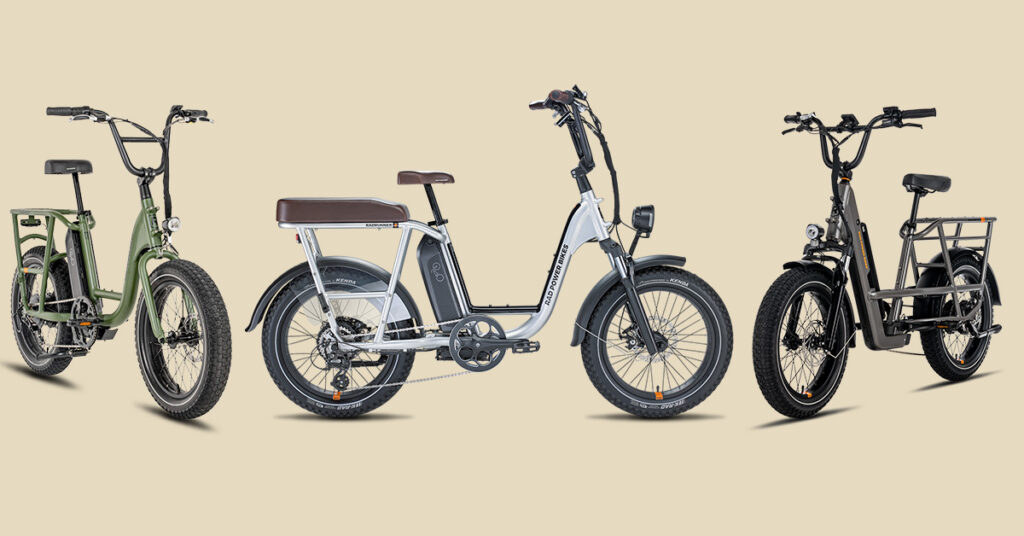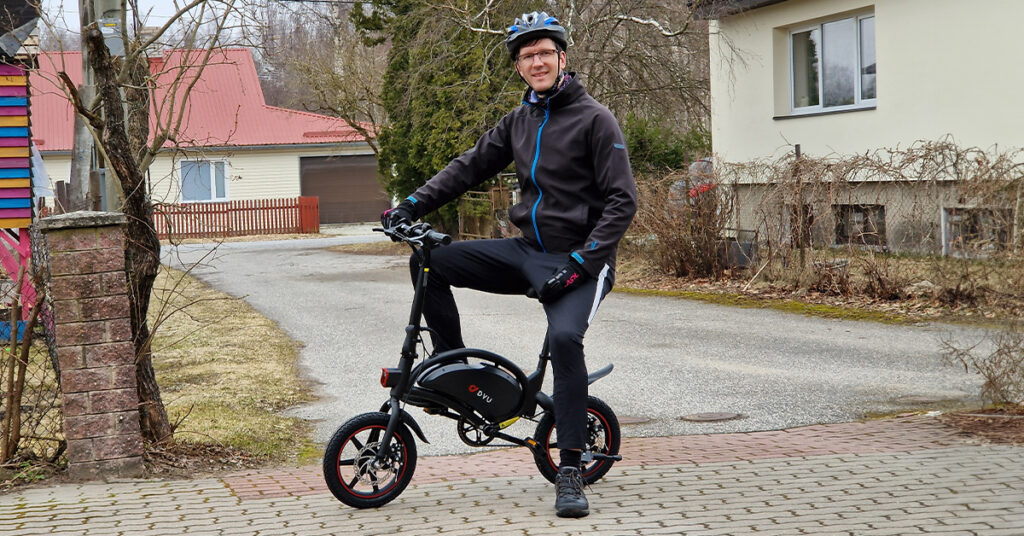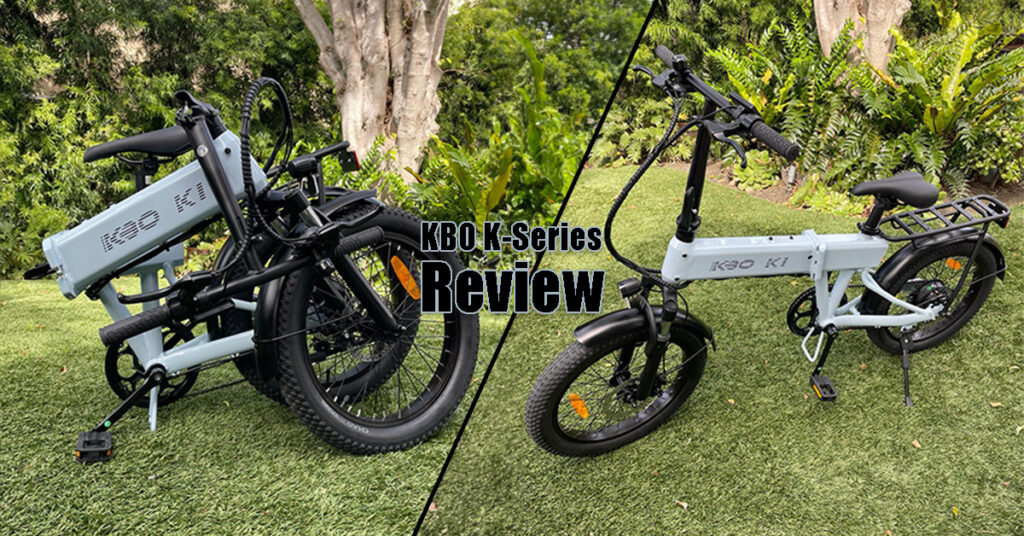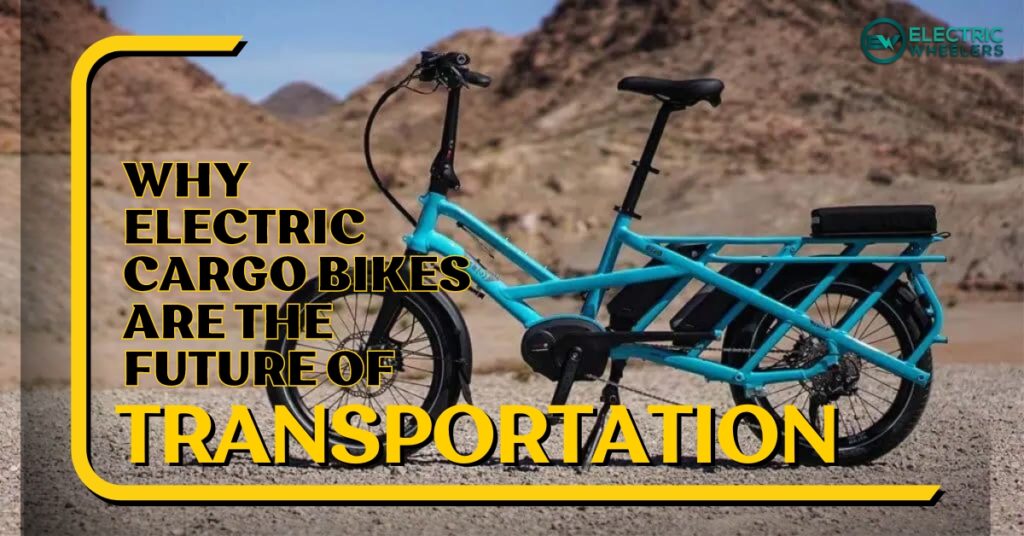Navigating the world of electric bikes can be a maze, especially when models seem so similar.
In this article, we’ll delve deep into the differences between the RadRunner 2, RadRunner Plus, and RadRunner 3 Plus. From frame design to ride experience, we’ve got you covered.
So, if you’re torn between these models or just curious, keep reading to make an informed decision. Let’s dive in!
Electric Wheelers is reader-supported. Although we independently research and test products, we may receive a commission on purchases made from our chosen links. Read more…
Table of Contents
RadRunner 2 vs RadRunner Plus vs RadRunner 3 Plus: What’s the Same?
All three models, the RadRunner 2, RadRunner Plus, and RadRunner 3 Plus, hail from the reputable Rad Power Bikes brand, known for its commitment to quality and innovation.
At their core, these e-bikes share a moped-style, step-thru frame design, making them accessible for riders of various heights.
Each bike boasts a robust 48V, 14Ah battery, paired with a 750-watt rear motor, ensuring consistent power and performance. Tektro disc brakes provide reliable stopping power across the trio, while BMX handlebars offer riders a comfortable grip and control.
RadRunner 2 vs RadRunner Plus vs RadRunner 3: Wheels & Tires
The wheels and tires of an e-bike are foundational to the ride experience of any e-bike. When it comes to the RadRunner series, there’s a remarkable consistency across the models in this department.
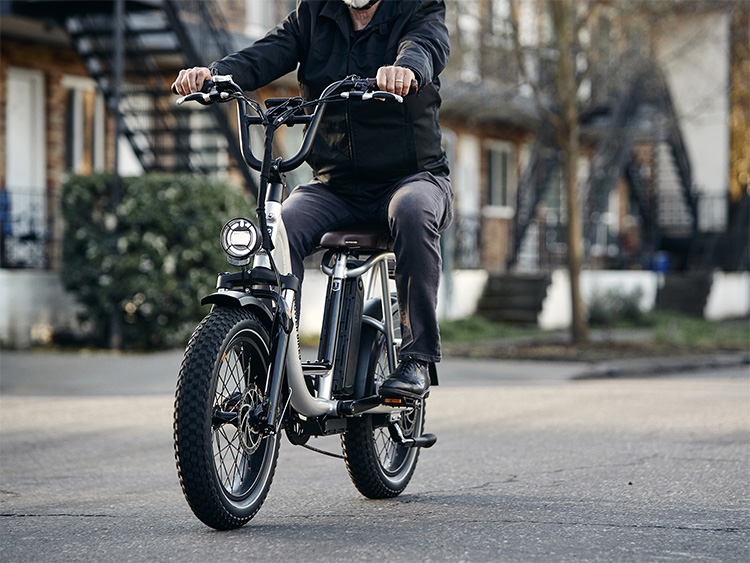
All three models, the RadRunner 2, RadRunner Plus, and RadRunner 3 Plus, are equipped with 20″ wheels, ensuring a stable and comfortable ride. This size is versatile, making it suitable for city commutes, leisure rides, and even some light off-road adventures.
As for the tires, each model has 3.3 inches-wide Kenda tires. They include the K-Shield puncture-resistant liner, ensuring a reduced risk of flats. Additionally, these tires have a reflective stripe for better security.
Despite their similarities, each model has unique features that set it apart. Let’s explore these differences in detail.
RadRunner 2 vs RadRunner Plus vs RadRunner 3 Plus: What’s the Difference?
While the RadRunner 2, RadRunner Plus, and RadRunner 3 Plus share foundational similarities, they diverge in several key aspects. These differences range from frame enhancements and tire specifications to groupset variations and braking systems.
Additionally, the ride experience and additional features each model offers can vary, impacting the overall value and appeal for potential riders. As we delve deeper into this comparison, we’ll uncover the nuances that might make one model more suitable for your needs than the others.
Let’s break down these distinctions.
RadRunner 2 vs RadRunner Plus vs RadRunner 3: Frame
The frame is the backbone of any bike, and in the case of the RadRunner series, it’s where many of the distinctions lie.
RadRunner 2: The RadRunner 2 boasts a moped-style frame, which is both stylish and functional. It’s designed for easy mounting and dismounting, making it a favorite among city commuters and seniors. However, it’s worth noting that this model has a rigid frame, meaning it doesn’t have any built-in shock absorption in the frame itself.
RadRunner Plus: The RadRunner Plus carries forward the moped-type design but introduces a front fork suspension. This addition provides riders with a smoother experience, especially when navigating bumpy terrains. The suspension ensures that shocks from uneven surfaces are absorbed, offering a more comfortable ride. The Plus also comes with an integrated rear seat, enhancing its utility for those who need to carry a passenger.
RadRunner 3 Plus: The frame design for the RadRunner 3 Plus remains largely similar to its predecessors, maintaining the moped style with BMX handlebars and a step-thru frame. However, it introduces a sturdier frame, allowing for a higher total weight capacity of 350 lbs, 50 lbs more than the RadRunner 2 and RadRunner Plus. This enhancement is a nod to its premium positioning, ensuring it can handle more weight, whether it’s cargo or passenger. Another subtle but significant improvement is the pannier rails, making it easier to mount bags.

While all three models share a foundational frame design, the RadRunner Plus and RadRunner 3 Plus offer enhancements that improve ride comfort and utility.
The choice between them would depend on the rider’s preference for suspension and weight capacity needs.
RadRunner 2 vs RadRunner Plus vs RadRunner 3: Groupset
The groupset, or drivetrain, of an e-bike plays a pivotal role in determining how the bike performs on different terrains and ride conditions. Let’s delve into the groupset differences among the RadRunner models.
RadRunner 2: The RadRunner 2 stands out with its simplicity. It features a single-speed drivetrain. This means there’s only one gear, making it straightforward for riders who prefer not to shift gears frequently. While this setup is ideal for flat terrains and city commutes, it might pose challenges on hilly terrains. However, in those moments, the electric motor becomes even more important.
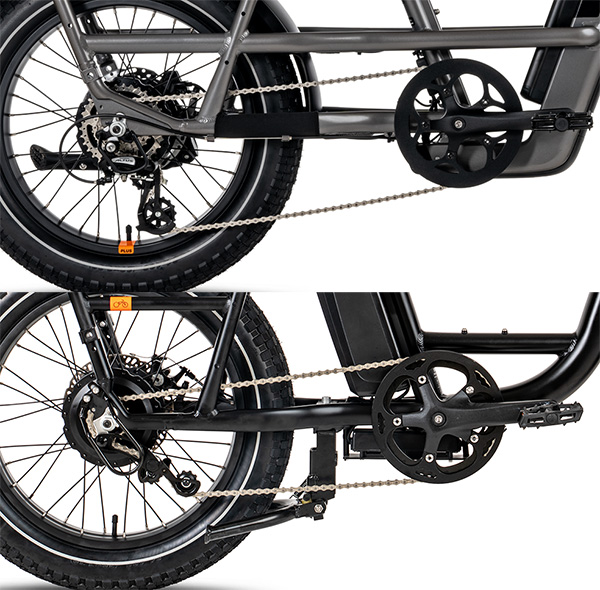
RadRunner Plus & RadRunner 3 Plus: Both these models come equipped with a more versatile 7-speed gearing system, specifically the Shimano Altus MD310 7s Derailleur. This setup provides riders with a broader range of gears to choose from, making it easier to tackle varying terrains, from steep inclines to flat roads. The freewheel on these models is an 11-34, paired with a 48T chainring, offering a good range for both climbing and cruising.
In essence, while the RadRunner 2 offers simplicity with its single-speed setup, the RadRunner Plus and RadRunner 3 Plus provide more versatility with their 7-speed drivetrains. Riders who anticipate diverse terrains or those who prefer having multiple gear options might lean towards the latter two models.
RadRunner 2 vs RadRunner Plus vs RadRunner 3: Brakes
Brakes are a critical component of any bike, ensuring safety and control during rides. The type and quality of e-bike brakes can significantly impact the stopping power and overall riding experience. Let’s explore the braking systems of the RadRunner models.
RadRunner 2 & RadRunner Plus: Both these models are equipped with the Tektro Aries caliper (MD-M300). These are mechanical disc brakes, known for their reliability and ease of maintenance. Mechanical brakes are activated by a cable, which pulls the brake pads against the rotor to create friction and stop the bike. While they might require occasional adjustments, they’re generally straightforward to maintain and are effective for everyday commuting and casual rides.

RadRunner 3 Plus: The RadRunner 3 Plus takes braking up a notch with the Tektro Hydraulic HD-E350 brakes. Unlike mechanical brakes, hydraulic brakes use fluid to transfer force from the lever to the brake pads. This results in smoother, more responsive braking with less hand effort. Hydraulic brakes also offer better modulation, allowing riders to control the intensity of their braking with precision. They’re especially beneficial in wet conditions, providing consistent stopping power.
Riders prioritizing advanced braking capabilities might find the RadRunner 3 Plus more appealing.
RadRunner 2 vs RadRunner Plus vs RadRunner 3: Display
The display on an e-bike is more than just a screen; it’s the rider’s interface to the bike’s electronic system. Let’s explore the differences in the displays across the RadRunner models.

RadRunner 2: The RadRunner 2 is equipped with an LED display. This simple display showcases five bars for the battery indicator, modes of assist, lights, and buttons for light and power. While it offers essential information, it doesn’t provide detailed metrics like miles per hour or total miles ridden.
RadRunner Plus: Stepping up, the RadRunner Plus comes with an LCD display, a feature that has been a staple in many Rad Power Bikes models. This display provides riders with more detailed information, including miles per hour, odometer, trip odometer, and more. It offers a more comprehensive view of the bike’s performance and metrics.
RadRunner 3 Plus: The RadRunner 3 Plus boasts an upgraded dual LCD display. These screens offer a plethora of information, including a charge indicator, speedometer, odometer, trip odometer, motor watts, headlight/taillight indicator, trip time, clock, and pedal assist level. With five levels of pedal assist displayed and a 12-magnet cadence sensor, riders get a detailed insight into their ride.
The RadRunner 3 Plus, with its dual LCD, stands out as the most advanced in terms of display features and functionalities.
RadRunner 2 vs RadRunner Plus vs RadRunner 3: Kickstand
Kickstand is such a minor component of an e-bike but since there is quite a big difference between these models, I have to tell you this.
RadRunner 2: The RadRunner 2 is equipped with a dual-leg, spring-loaded kickstand made of steel. This design offers enhanced stability by distributing the bike’s weight evenly on both legs. It’s especially beneficial for e-bikes, ensuring that the bike remains stable even when loaded with cargo or when parked on uneven terrains.
RadRunner Plus & RadRunner 3 Plus: Both these models come with a side-mounted kickstand that features an adjustable lean angle. This design allows riders to adjust the angle at which the bike leans when parked, ensuring stability on various surfaces. While it provides flexibility in terms of parking angles, it might not offer the same level of stability as the dual-leg design on uneven grounds.

RadRunner 2 vs RadRunner Plus vs RadRunner 3: Lights
Here’s how the RadRunner models stack up in terms of their lighting systems:
RadRunner 2: The RadRunner 2 features a basic integrated headlight. While it provides adequate illumination for nighttime rides, it might not be as feature-rich as the lights on the other models. It’s essential for riders to ensure that this light is always functional and might consider adding supplementary lights for enhanced visibility.
RadRunner Plus & RadRunner 3 Plus: Both these models are equipped with the same premium integrated headlight. This headlight not only offers superior illumination but also comes with additional features like a halo daytime running light. The halo light ensures that riders are visible even during the day, significantly enhancing safety. Additionally, the design of this headlight is sleek and adds to the aesthetic appeal of the e-bikes.
RadRunner 2 vs RadRunner Plus vs RadRunner 3: Fenders
Here’s a breakdown of the fender offerings across the RadRunner models:
RadRunner 2: This model offers a more customizable approach. While it doesn’t come with fenders in its base package, riders have the option to purchase them separately, tailoring the bike to their specific needs and preferences.
RadRunner Plus & RadRunner 3 Plus: Both these models come standard with premium full fenders. These fenders are not just functional, providing maximum protection against the elements, but they also enhance the bike’s overall aesthetic. Their extended coverage ensures that riders remain clean and dry, regardless of the weather.
RadRunner 2 vs RadRunner Plus vs RadRunner 3: Ride Experience
The RadRunner 2’s single-speed drivetrain simplifies the ride, making it straightforward and fuss-free. However, this might limit its versatility on varied terrains. On the other hand, the RadRunner Plus and RadRunner 3 Plus, with their 7-speed drivetrains, promise adaptability, allowing riders to tackle hills and flats with equal ease.
The braking system also plays a pivotal role. While the RadRunner 2 and RadRunner Plus rely on mechanical brakes, the RadRunner 3 Plus boasts hydraulic brakes, offering enhanced stopping power and control. This difference can be particularly noticeable in wet conditions or during sudden stops.
RadRunner 2 vs RadRunner Plus vs RadRunner 3: Pricing
When it comes to investing in an e-bike, pricing plays a crucial role in the decision-making process. As of now, the RadRunner 2 is the most budget-friendly option at $1499, making it an attractive choice for those looking for quality without breaking the bank.
Stepping up, the RadRunner Plus is priced at $1999, offering additional features and enhancements for the extra cost.
The RadRunner 3 Plus, being the premium model, comes in at $2299, reflecting its advanced specifications and top-tier components.
While these prices provide a current snapshot, it’s worth noting that Rad Power Bikes frequently offers promotions and discounts. Prospective buyers are encouraged to check the official website for the latest pricing and potential deals.
RadRunner 2 vs RadRunner Plus vs RadRunner 3: How to Choose?
Choosing between the RadRunner 2, RadRunner Plus, and RadRunner 3 Plus can seem daunting, but it boils down to your specific needs, preferences, and budget. Here’s a breakdown to help guide your decision:
- Budget-Conscious Buyers: If you’re looking for a reliable e-bike without stretching your budget, the RadRunner 2 is your go-to. It offers a solid ride experience and essential features, making it a great value for its price.
- Feature Enthusiasts: The RadRunner Plus is for those who desire a balance between cost and added features. With its premium saddle, integrated lights, and full fenders, it’s a step up from the base model. It’s ideal for riders who want enhanced comfort and functionality without going all out on the premium tier.
- Premium Seekers: If you’re in the market for top-tier specs and are willing to invest a bit more, the RadRunner 3 Plus is your match. It boasts advanced components like hydraulic brakes, a high-quality display, and full fenders. This model is perfect for those who want the best of the best and are willing to pay for those premium touches.
In conclusion, your choice should align with what you value most in an e-bike, whether it’s cost-effectiveness, advanced features, or ride quality. Each RadRunner model has its unique strengths, ensuring there’s a perfect fit for every rider.

The founder and the editor-in-chief of the Electric Wheelers blog. With a previous background in IT, sales, and video editing, he has now established himself as a micromobility expert.
He bought his first e-scooter over 5 years ago and since then has owned dozens of e-scooters and e-bikes. His deep understanding of the technical aspects, coupled with a keen eye for market trends, enables him to provide insightful and reliable content.
His commitment to promoting sustainable and efficient urban mobility solutions has made him a respected voice in the community of eco-friendly transportation enthusiasts.

